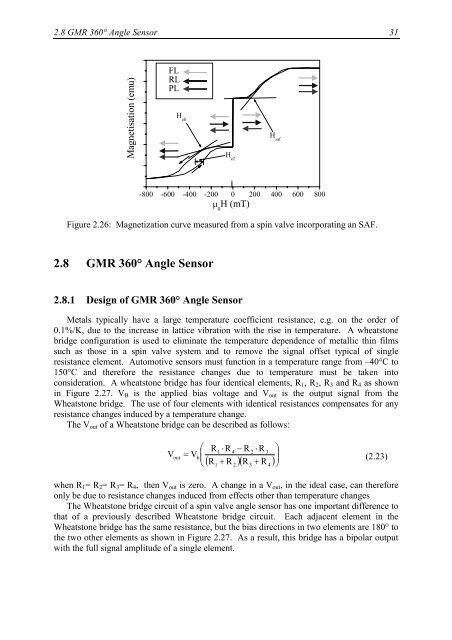Spin Valve Systems for Angle Sensor Applications - tuprints
Spin Valve Systems for Angle Sensor Applications - tuprints
Spin Valve Systems for Angle Sensor Applications - tuprints
You also want an ePaper? Increase the reach of your titles
YUMPU automatically turns print PDFs into web optimized ePapers that Google loves.
2.8 GMR 360° <strong>Angle</strong> <strong>Sensor</strong> 31<br />
Magnetisation (emu)<br />
FL<br />
RL<br />
PL<br />
H eb<br />
H c2<br />
H saf<br />
-800 -600 -400 -200 0 200 400 600 800<br />
µ 0 H (mT)<br />
Figure 2.26: Magnetization curve measured from a spin valve incorporating an SAF.<br />
2.8 GMR 360° <strong>Angle</strong> <strong>Sensor</strong><br />
2.8.1 Design of GMR 360° <strong>Angle</strong> <strong>Sensor</strong><br />
Metals typically have a large temperature coefficient resistance, e.g. on the order of<br />
0.1%/K, due to the increase in lattice vibration with the rise in temperature. A wheatstone<br />
bridge configuration is used to eliminate the temperature dependence of metallic thin films<br />
such as those in a spin valve system and to remove the signal offset typical of single<br />
resistance element. Automotive sensors must function in a temperature range from –40°C to<br />
150°C and there<strong>for</strong>e the resistance changes due to temperature must be taken into<br />
consideration. A wheatstone bridge has four identical elements, R1, R2, R3 and R4 as shown<br />
in Figure 2.27. VB is the applied bias voltage and Vout is the output signal from the<br />
Wheatstone bridge. The use of four elements with identical resistances compensates <strong>for</strong> any<br />
resistance changes induced by a temperature change.<br />
The Vout of a Wheatstone bridge can be described as follows:<br />
( )( ) ⎟⎟<br />
⎛ R<br />
⎞<br />
1 ⋅R<br />
4 − R 2 ⋅R<br />
3<br />
V =<br />
⎜<br />
out Vb<br />
(2.23)<br />
⎝ R1<br />
+ R 2 R 3 + R 4 ⎠<br />
when R1= R2= R3= R4, then Vout is zero. A change in a Vout, in the ideal case, can there<strong>for</strong>e<br />
only be due to resistance changes induced from effects other than temperature changes<br />
The Wheatstone bridge circuit of a spin valve angle sensor has one important difference to<br />
that of a previously described Wheatstone bridge circuit. Each adjacent element in the<br />
Wheatstone bridge has the same resistance, but the bias directions in two elements are 180° to<br />
the two other elements as shown in Figure 2.27. As a result, this bridge has a bipolar output<br />
with the full signal amplitude of a single element.

















